Highly-Rated Methods for Resolving a Leak in Your Garbage Disposal
Highly-Rated Methods for Resolving a Leak in Your Garbage Disposal
Blog Article
What're your ideas with regards to Why Is My Garbage Disposal Leaking From the Bottom??

Waste disposal unit are important kitchen devices that help in throwing away food waste successfully. Nevertheless, a leaking waste disposal unit can be an irritating and untidy problem to manage. Thankfully, numerous leaks can be taken care of conveniently with a couple of simple actions. In this write-up, we will certainly discuss how to take care of a leaking waste disposal unit effectively.
Intro
Waste disposal unit are set up under kitchen sinks and are designed to shred food waste right into smaller sized pieces, allowing it to go through the plumbing system conveniently. While these gadgets are generally reliable, leaks can take place over time due to deterioration, loosened links, or damages to the device.
Step-by-Step Overview to Repairing a Dripping Garbage Disposal
Shut off the Power
Prior to attempting any type of repair work, guarantee that the power to the garbage disposal device is switched off to avoid the danger of electric shock.
Locate the Leak
Recognize the precise place of the leakage and identify the reason
Tighten up Links
Use a wrench to tighten any loose connections in between the disposal device and the pipes system.
Replace Seals or Gaskets
If the leak is due to worn seals or gaskets, remove the old components and replace them with new ones.
Patching Cracks or Openings
For cracks or openings in the disposal device, usage epoxy or an ideal patching material to secure the broken area.
Identifying the Resource of the Leakage
Before attempting to deal with a dripping garbage disposal, it is vital to determine the source of the leak. This can normally be done with aesthetic examination or by carrying out straightforward examinations.
Visual Evaluation
Check the waste disposal unit device very carefully for any kind of indicators of water leakage. Pay close attention to locations around seals, gaskets, and connection points.
Evaluating for Leakages
One method to examine for leaks is by running water with the disposal system and checking for any type of visible indications of leakage.
Usual Root Causes Of Leaks in Trash Disposals
Worn Seals and Gaskets
Seals and gaskets play a vital duty in avoiding water from leaking out of the garbage disposal. Gradually, these parts can deteriorate, bring about leakages around the disposal unit.
Loose Connections
The links between the waste disposal unit and the pipes system can become loosened with time, creating water to leakage out during operation.
Cracks or Holes in the Disposal System
Physical damages to the waste disposal unit, such as splits or openings in the real estate, can likewise cause leakages.
Devices and Materials Needed for Taking Care Of a Dripping Garbage Disposal
Prior to beginning the repair process, collect the required devices and materials, including a screwdriver, flexible wrench, plumbing technician's putty, replacement seals or gaskets, and epoxy or patching product for repairing fractures or openings.
Evaluating the Garbage Disposal After Repair
As soon as the fixing is full, check the garbage disposal by running water with it to ensure that the leakage has actually been solved.
Preventive Upkeep Tips to Prevent Future Leaks
To stop future leakages, it is essential to carry out regular upkeep on your garbage disposal. This consists of maintaining it clean, staying clear of putting non-food products or difficult items down the disposal, and periodically looking for leaks or various other problems.
Final thought
In conclusion, repairing a dripping garbage disposal is a relatively simple procedure that can be finished with fundamental devices and products. By complying with the steps detailed in this article and exercising preventative maintenance, you can maintain your garbage disposal in good working condition and avoid costly fixings in the future.
What to Do About a Leaking Garbage Disposal
A leaking garbage disposal often goes unnoticed until you confront a sopping cabinet, a foul-smelling puddle, or an audible drip-drip-drip from the unit. The fix can be frustrating, too, because the leak can stem from a number of components in the system. Fortunately, with a little sleuthing, you can zero in on the leak and—depending on the exact location—stop the icky oozing and repair the component that caused it. Worst case scenario, if it turns out that the garbage disposal must be replaced, installing a new one is a reasonable do-it-yourself task for those with basic plumbing skills. Read on to keep the cash you’d otherwise hand over to a pro.
Prepare to find the leak
Prior to testing the garbage disposal for leaks, unplug it at the wall outlet and turn off the power from the breaker box to prevent electrical shock. Then insert a watertight sink stopper into your sink drain and wipe the unit dry with a clean cloth. In any handy container, mix a few drops of food coloring into a few cups of water, and pour the dyed water onto the sink stopper to help you locate the leak.
Investigate the source
the top, where the disposal meets the sink drain the side, where the dishwasher hose or main drain pipe connects to the disposal or the bottom of the unit Inspect each of these locations while gliding a light-colored rag over the unit; the dyed water will readily show on the rag and reveal the location of the leak. If a leak isn’t immediately apparent, remove the sink stopper and pour a few more cups of dyed water down the sink drain, then check for leaks again. Leaks near the top of the unit are more likely to show themselves while the sink is plugged, while side and bottom leaks are more noticeable while the sink is unplugged.
The metal sink flange that sits directly inside the sink drain is typically sealed around the top with plumber’s putty (a clay-like sealant) and then secured from under the sink with bolts. If the plumber’s putty deteriorates, or the bolts loosen, the flange can no longer form a watertight seal between the sink drain and the disposal—which could cause a leak at the top of the unit.
To reseal the leaky flange, you must first detach the garbage disposal. Start by loosening the screws securing the main drain pipe to the disposal, then loosen the screws in the metal clamp securing the dishwasher hose to the disposal and detach the drain pipe and dishwasher hose from the disposal. Loosen the screws in the mounting ring that connects the disposal to the metal mounting assembly beneath the sink, then pull down the disposal and carefully set it on a clean, dry surface. Loosen the bolts in the mounting assembly with a wrench, then pull down the mounting assembly and set it near the disposal.

I am just very fascinated by Why Is My Garbage Disposal Leaking From the Bottom? and I really hope you liked the new blog post. Sharing is good. You just don't know, you could be doing someone a favor. I praise you for your time. Visit us again soon.
Details Report this page